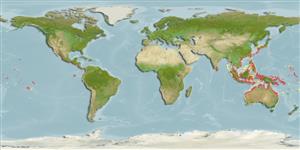Common names from other countries
Classification / Names / Names
ชื่อสามัญ | ชื่อพ้อง | Catalog of Fishes (gen., sp.) | ITIS | CoL | WoRMS
Environment: milieu / climate zone / depth range / distribution range
นิเวศวิทยา
เกี่ยวกับหินโสโครก; ระดับความลึก 0 - 5 m (Ref. 96667). Tropical
Indo-Pacific.
Length at first maturity / ขนาด / น้ำหนัก / Age
Maturity: Lm ? range ? - ? cm Max length : 10.0 cm CW เพศผู้/กระเทย; (Ref. 128968); น้ำหนักสูงสุดที่มีการรายงาน: 100.00 g (Ref. 128968)
The carapace is bright orange in color with mosaic patterns. The walking legs have small hairs in their border (Ref. 128968)
Adults live along coral areas (Ref. 128968). This species is known to be one of the most poisonous crabs in the world. Its neurotoxin does not get denatured by heat even when cooked. It acquires the poisonous neurotoxin from its food, including a poisonous sea cucumber (Ref. 85383). Intertidal (Ref. 106854). Inhabits littoral and sublittoral areas with rocky and coral rubble substrates, and coral reefs (Ref. 85383).
Life cycle and mating behavior
วัยเจริญพันธุ์ | การสืบพันธุ์ | การวางไข่ | เซลสืบพันธ์ของเพศเมีย(ไข่) | ความดกของไข่ | ตัวอ่อน
Members of the order Decapoda are mostly gonochoric. Mating behavior: Precopulatory courtship ritual is common (through olfactory and tactile cues); usually indirect sperm transfer.
Yeo, D.C.J., T. Swee Hee and P.K.L. Ng. 2008. (Ref. 85383)
IUCN Red List Status (Ref. 130435)
CITES status (Ref. 108899)
Not Evaluated
Not Evaluated
Threat to humans
Poisonous to eat (Ref. 85383)
Human uses
| FishSource |
เครื่องมือ
แหล่งที่มาจากอินเตอร์เน็ต
Estimates based on models
Preferred temperature
(Ref.
115969): 22.8 - 29.3, mean 28.5 (based on 2762 cells).
